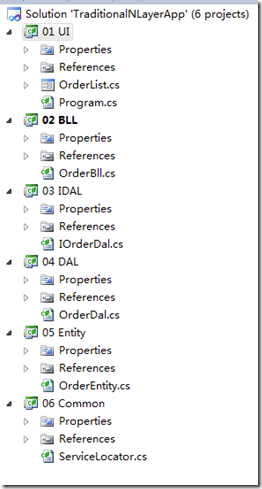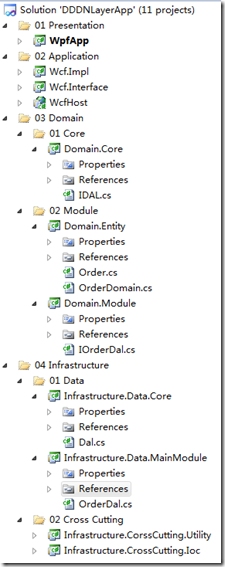小议传统分层与新式分层,抑或与DDD分层
2011-01-10 14:42 Virus-BeautyCode 阅读(4034) 评论(26) 收藏 举报
| 引言 |
本文提到的分层只是软件架构上的分层。文中的传统分层指的是传统的三层结构:UI(界面表现层),BLL(业务逻辑层),DAL(数据访问层)。文中提出的观点也都是个人的一点认识,与任何组织没有关系,如有异议,还请各位踊跃拍砖。
当然了,出现的这些问题,也可能只是我个人的问题,不代表每个人都存在。无则加勉,有则改正吧。如果是个人的问题,那就当是个人总结吧,大家看看就算了。
这里说到的传统分层,也有可能是我对于分层的错误理解造成的,但是我看见的不只是我的项目是这么的结构,很多的项目也都是这样的结构。里面的代码, 都和我理解的一样,至少可以说明,还是有一部分人犯了和我一样的错误。
| 传统分层 |
传统分层最大的问题就在于割裂了上层与下层之间的联系,把他们之间的关系变成了简单的接口调用,变成了完全的接口形式主义。同时,忽略了下层是为上层提供服务的,不是单独存在的,下层提供的服务应该受到上层的规约。当然,也不是说不可以提供更多的服务,但是至少应该提供上层需要的,然后再考虑提供一些“边角料”。
我们先看一个传统分层的解决方案结构。
相互之间的引用关系是:UI引用BLL、Entity、Common;BLL引用IDAL、Entity、Common;IDAL引用Entity;DAL引用IDAL、Entity、Common。
{{OrderSeqNo = "123",
{IOrderDal _orderDal;public OrderBll(){{return _orderDal.Add(order);
{
{{IDbCommand comm = conn.CreateCommand();IDbDataParameter param = comm.CreateParameter();param.Direction = ParameterDirection.Input;param.DbType = DbType.String;param.ParameterName = "OrderSeqNo";if (comm.ExecuteNonQuery() > 0)return true;elsereturn false;
using System.Configuration;using System.Globalization;using Microsoft.Practices.Unity;using Microsoft.Practices.Unity.Configuration;using Microsoft.Practices.Unity.InterceptionExtension;using System.Web;using System;namespace Common{{// private static readonly InterfaceInterceptor injector = new InterfaceInterceptor ();{get;private set;static ServiceLocator(){{Container.AddNewExtension<Interception>();unitySection.Configure(Container, "Container");/// <summary>/// <typeparam name="T"></typeparam>/// <returns></returns>{Container.Configure<Interception>().SetDefaultInterceptorFor<T>(injector);return Container.Resolve<T>();/// <summary>/// <typeparam name="T"></typeparam>/// <param name="serviceName"></param>/// <returns></returns>{Container.Configure<Interception>().SetDefaultInterceptorFor<T>(injector);return Container.Resolve<T>(serviceName);
上层在调用下层的时候,不是调用自己需要的,而是从下层提供的服务中筛选一些可以用的,凑合用一下。如果发现没有自己可以用的,就在IDAL文件中添加一个,然后在DAL文件中实现以下,这下好了,BLL可以用了。这样也会造成在开发DAL层的时候,没有充分考虑BLL的需要,自己盲目实现一些,然后BLL用的时候,才发现很多还要重新写。造成大量的浪费,代码、人力、时间、精力都浪费一部分了。也会影响到开发的进度。
| 新式分层,抑或叫做DDD分层 |
说是新式分层,其实也是我随便叫的。就是这段时间看了博客园的一些DDD文章,还有就是codeplex上的两个项目NLayerApp和SmartCA的源码。看了这些之后,有的一点理解。不管是神似还是形似吧,反正觉得比以前传统分层有一点道理,就分享出来了,也挣点人气,骗点点击量,哈哈。
先来一张图吧。
DDD中的分层主要是四层:Presentation(表现层),Application(应用层),Domain(领域层),Infrastructure(基础层)。
Presentation相当于以前的UI层。Application是一个任务的调度层,没有实际的业务逻辑,也不推荐放入业务逻辑,实际中可以用Wcf来代替,或者使用普通的类库就可以。其实就是根据UI的业务调用,然后映射到具体的领域对象身上去。也可以通过Application来暴露粗粒度的业务处理,因为领域层的业务处理是细粒度的。没有了以前的DAL,把它的部分放入了Infrastructure层。
以前的IDAL被放入了Domain,在图上,是Domain.Core项目,这个项目会被Infrastructure引用。因为Domain.Core中的IDAL相当于是领域对象对于持久化提出的要求,也就是说必须要实现这些功能,这些都是领域对象需要的。具体的如何实现,具体如何持久化,是持久化到关系数据库还是文件系统,还是内存数据库,都由具体的实现来定义。也就是图中的Infrastructure.Data.Core和Infrastructure.Data.MainModule项目。这两个项目中的实现,实现的都是领域对象持久化所需要的,不会实现一大丢不必要的方法。不知道这算不算是改进呢?
| 结论 |
传统分层,或者说是我理解的传统分层,存在的问题就是割裂层之间的联系,形式化了层之间的联系。没有表达出上层对于下层的需要,下层是为上层服务的,这些联系。DDD的分层可以解决这个问题,会提高开发的效率,少走一些弯路。
不知道大家是如何认识的呢????????期待大家的回复,拍砖。




 浙公网安备 33010602011771号
浙公网安备 33010602011771号